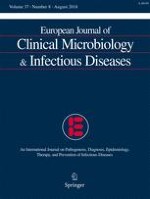Erschienen in:

07.05.2018 | Original Article
Occult bacteremia etiology following the introduction of 13-valent pneumococcal conjugate vaccine: a multicenter study in Spain
verfasst von:
Susanna Hernández-Bou, Borja Gómez, Santiago Mintegi, Juan J. García-García, On behalf of the Bacteraemia Study Working Group of the Infectious Diseases Working Group of the Spanish Society of Paediatric Emergencies (SEUP)
Erschienen in:
European Journal of Clinical Microbiology & Infectious Diseases
|
Ausgabe 8/2018
Einloggen, um Zugang zu erhalten
Abstract
Little is known about occult bacteremia (OB) in Spain following the introduction of the 13-valent pneumococcal conjugated vaccine (PCV13). Our aim was to describe the microbiologic characteristics and management of OB among children aged 3–36 months in Spain in the era of PCV13. Data were obtained from a multicenter registry of positive blood cultures collected at 22 Spanish emergency departments (ED). Positive blood cultures performed on patients aged 3–36 months from 2011 to 2015 were retrospectively identified. Immunocompetent infants with a final diagnosis of OB were included. Non-well-appearing patients and patients with fever > 72 h were excluded. We analyzed 67 cases (median age 12.5 months [IQR 8.7–19.4]). Thirty-seven (54.4%) had received ≥ 1 dose of PCV. Overall, 47 (70.1%) were initially managed as outpatients (38.3% of them with antibiotic treatment). Phone contact was established with 43 (91.5%) of them after receiving the blood culture result and 11 (23.4%) were hospitalized with parenteral antibiotic. All patients did well. Streptococcus pneumoniae was isolated in 79.1% of the patients (42.2% of the isolated serotypes were included in the PCV13). S. pneumoniae remains the first cause of OB in patients attended in the ED, mainly with non-PCV13 serotypes. Most of the patients with OB were initially managed as outpatients with no adverse outcome.











